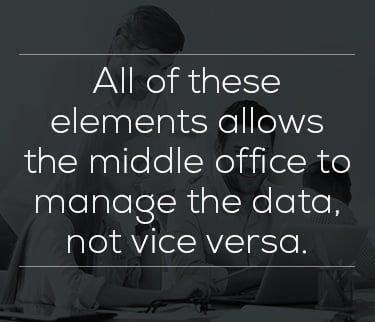How smart machines can benefit a middle office now – and a glimpse into an automated future.

Speed and accuracy are both fundamental elements of the middle office. The two are intrinsically linked to better performance. But what happens when there is a problem? Anomalies need to be flagged, and they need to be flagged quickly. And, of course, they need to be fixed to keep the data clean.
But the ability to do both relies on having the right data inputs, and the right controls with rules-based processing. If a system can pinpoint where an exception has occurred and work to remedy that, then the need to go back to square one is avoided. This saves crucial time and means that processing is speedy and efficient – essential in today’s time-pressured environment.
Exceptions-based management also means that if there is no issue identified then there is no problem to address. Unless something is flagged, the data can be assumed to be fine.
The perils of manual processes
This is in sharp contrast to non-automated systems, where the process is inherently slower and clunkier. In this scenario problems are more likely to arise, take longer to deal with, and can sometime even slip through the net. And while lengthy workarounds are far from ideal, not picking up anomalies at all can be disastrous.
There are a number of ways in which non-automated systems can can cause problems:
- Some systems run reports without raising errors. This means the middle office needs to manually check the data later on, adding time and the risk of human error to the process.
- Others may identify anomalies but do nothing to remedy the situation. Quite simply, they are not smart enough to do anything about it.
- Or perhaps the system can perform one basic action for a specific scenario, but is powerless when faced with a multitude of scenarios or possibilities.
So what’s the secret to automating performance measurement, whereby anomalies are automatically picked up and corrected quickly – without the need to go back to the beginning?
Smart solutions, improved performance
Key to all this is having the right data sources that are subsequently well-managed and organized throughout the workflow. If this is the case then the system, having been intelligently programmed, can manage by exception. It can be taught how to identify numerous scenarios, and what correct course of action should be taken for each issue. It can also automatically reimport data if required.
A smart system can also provide an audit trail for all its exceptions management, including having an independent, four-eyes validation and sign-off process – all of which can be added to the book of records.
It also means that instead of stopping the whole system and going back to the beginning, only the parts that need looking at, the exceptions, need work.
The benefits are transparent:
- Exceptions are managed in a timely and efficient way.
- Their management is automated and rules-based, meaning no nasty surprises.
- The ideal system should be highly visual so that the user can, at a glance, see where the problem is and what the system is doing to resolve it.
- The system should show how long it will take to resolve the exception and the current progress being made.
All of these elements allows the middle office to manage the data, not vice versa. Exceptions are always likely, but managing them efficiently and without drama means that the middle office can do its job effectively and work to provide the very best service possible.
The future will be even more automated
Technology has improved at such a pace that the old way of doing things now seems old-fashioned at best, antiquated and even laughable at worst. And technology will continue to open new doors in the near future. Systems can currently be programmed to recognize scenarios and follow instructions in a given situation, but they are not yet able to learn from their experience.
This is coming, though. Soon systems will be able to remember a scenario, recognize when it happens again, and know how to take steps beyond merely fixing what is directly in front of it. This includes sometimes knowing that it needs human input and referring a problem back for human analysis.
Overall things are moving in the right direction, and exception management via smart systems has improved exponentially. Their input is invaluable to getting competitive advantage through quick, timely, and (crucially) accurate data. Automation and getting rid of manual tasks in exceptions management means that a middle office can trust the system to flag and correct anomalies automatically, and that ultimately staff are free to add value elsewhere.
Key takeaways:
- The system needs to pinpoint where an exception has occurred without going right back to square one
- It also needs to have a recognizable library of scenarios and know what to do in a number of different situations
- The system will also audit the action, so the middle office can report it in the book of records
- The next level of machine learning will see systems with the capability to remember a scenario, recognize when it happens again, and learn from previous experiences
Learn more about the future of middle office automation in our complimentary eGuide, How can we automate and scale the middle office?
{{cta(‘d18596d6-0dd0-4ebc-be8c-391bd00cd49a’)}}